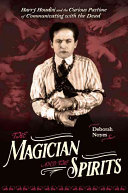2018 School Spending Survey Report
The Magician and the Spirits: Harry Houdini and the Curious Pastime of Communicating with the Dead
160p. bibliog. index. notes. photos. Viking. Aug. 2017. Tr $18.99. ISBN 9780803740181.
COPY ISBN
 Gr 6 Up—Harry Houdini is best remembered as a magician and escape artist, but he also spent more than half his life tirelessly investigating mediums and séances—charlatans in disguise. Noyes's narrative blends the history of the spiritualism movement in the early 20th century with a biographical account of Houdini. Early in Houdini's career, between 1897 and 1899, he and his wife Bess performed as mediums and mind readers, but he later wrote that he regretted "trifling with the hallowed reverence which the average human being bestows on the departed." Influenced by the loss of his beloved mother in 1913 and his ongoing debate with friend and avid spiritualist Sir Arthur Conan Doyle, Houdini embarked on a mission to debunk spiritualism, which by 1924 "had become a full-on crusade." Noyes stresses that Houdini believed in an afterlife and probably hoped that communication with the dead was possible but he never found legitimate evidence. Since magic acts and fraudulent séances made use of many of the same methods, Houdini was adept at discovering trickery, which he exposed most notably in a 1924 lecture tour. Houdini is portrayed as a likable figure, motivated by his compassion for grieving people and respect for the deceased. The title has an appealing layout with frequent sidebars, copious photographs and archival theater posters, and a page border that subtly contributes to the book's Victorian flavor and spooky mood. Although some passages are a bit dry, the read is overall intriguing and likely to hook students.
Gr 6 Up—Harry Houdini is best remembered as a magician and escape artist, but he also spent more than half his life tirelessly investigating mediums and séances—charlatans in disguise. Noyes's narrative blends the history of the spiritualism movement in the early 20th century with a biographical account of Houdini. Early in Houdini's career, between 1897 and 1899, he and his wife Bess performed as mediums and mind readers, but he later wrote that he regretted "trifling with the hallowed reverence which the average human being bestows on the departed." Influenced by the loss of his beloved mother in 1913 and his ongoing debate with friend and avid spiritualist Sir Arthur Conan Doyle, Houdini embarked on a mission to debunk spiritualism, which by 1924 "had become a full-on crusade." Noyes stresses that Houdini believed in an afterlife and probably hoped that communication with the dead was possible but he never found legitimate evidence. Since magic acts and fraudulent séances made use of many of the same methods, Houdini was adept at discovering trickery, which he exposed most notably in a 1924 lecture tour. Houdini is portrayed as a likable figure, motivated by his compassion for grieving people and respect for the deceased. The title has an appealing layout with frequent sidebars, copious photographs and archival theater posters, and a page border that subtly contributes to the book's Victorian flavor and spooky mood. Although some passages are a bit dry, the read is overall intriguing and likely to hook students.
VERDICT Fans of magic, mystery, and debates on the supernatural will devour Noyes's take on Houdini.
RELATED
ALREADY A SUBSCRIBER? LOG IN
We are currently offering this content for free. Sign up now to activate your personal profile, where you can save articles for future viewing





Be the first reader to comment.
Comment Policy:
Comment should not be empty !!!